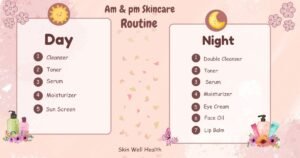Is Niacinamide Good for Oily Skin? (2024)
- Understanding Oily Skin
- What is Niacinamide?
- Is niacinamide good for oily skin?
- Benefits of Niacinamide for Oily Skin
- How Niacinamide Works on Oily Skin
- Niacinamide Vs. Other Ingredients
- How to Use Niacinamide in Your Skincare Routine
- Best Niacinamide Products for Oily skin
- Final Thoughts
- FAQs
- Sources
Hi guys! Are you tired of having oily skin? So, you have no need to worry about it because there is a hero, which is also known as vitamin B3, called “Niacinamide.” Think…….. It has a lot of benefits for skin as well as may be for your oily skin.
But is niacinamide good for oily skin? In this blog post, you will find in-depth research about it.
Understanding Oily Skin
Too much sebum production defines oily skin and can cause shine, enlarged pores, and irregular breakouts.
Proper care of oily skin depends on a balanced skincare routine and focusing on the underlying causes.
Common Problems
There are some common problems that oily skin can cause:
Too much shine — Too much oiliness results in shiny skin.
Enlarged pores — When your skin produces extra oil, your pores may look large.
Acne and breakouts — Overproduction of sebum can clog your pores and cause acne.
What is Niacinamide?
Niacinamide is a form of vitamin B3 that is water-soluble and can be found in many foods and supplements.
Dermatologists like it because it’s beneficial for the skin and has anti-inflammatory and antioxidant qualities.
General benefits for skin health
- Regulates Sebum Production
- Minimizes Pore Appearance
- Reduces Acne
- Improves Skin Barrier Function
- Reduces Hyperpigmentation and Redness
- Anti-Aging
- Moisturize the skin
- Antioxidant Properties
- Reduces Inflammation
- Improves Skin Texture and Tone
In the below image, you can see clearly a great reduction of pigmentation on the right side of the face.
According to the study, using niacinamide for 8 weeks decreases pigmentation and gives excellent results.
Is niacinamide good for oily skin?
Absolutely, niacinamide has been shown to improve oily skin. Niacinamide has a lot of benefits for skin, and it is suitable for all skin types, even oily skin.
A study published in PubMed found that 2% niacinamide effectively reduced sebum production rates after four weeks of use.
Benefits of Niacinamide for Oily Skin
There are several benefits of niacinamide for oily skin.
- Controls excess oil production
- Minimizes the appearance of pores
- Reduces acne and blemishes
- Improves skin texture and tone
- Strengthens the skin barrier
How Niacinamide Works on Oily Skin
Oil control. Niacinamide stops the skin from getting too oily by balancing the amount of oil that the sebaceous glands produce.
Reduce the size of pores. Niacinamide can reduce the appearance of pores by making the skin more elastic and improving the skin barrier.
Anti-inflammatory. It reduces redness and inflammation, which is beneficial for skin that develops acne.
Niacinamide Vs. Other Ingredients
| Niacinamide Vs. Other Ingredients | Benefits of Other Ingredients | Benefits of Niacinamide | Combination |
|---|---|---|---|
| Niacinamide vs. Salicylic Acid | Salicylic acid removes dead skin cells and clears pores. | Niacinamide focuses on reducing oil production and inflammation. | Together, they can provide stronger results. |
| Niacinamide vs. Benzoyl Peroxide | Benzoyl peroxide targets acne-causing bacteria. | Oil control and skin soothing. Niacinamide is gentle for sensitive skin. | Together, you can get better results. |
Also note….
Combining items like hyaluronic acid and retinol with niacinamide can make its benefits more effective.
For example, hyaluronic acid helps to keep the skin hydrated, and retinol increases the growth of cells.
How to Use Niacinamide in Your Skincare Routine
The first step is to choose the right products. Look for moisturizers and serums that have 5–10% niacinamide.
Tips on how to use
- Morning routine. Apply after cleansing and before sunscreen.
- Evening routine. Use after cleansing and before heavier creams or treatments.
- Layering. Niacinamide can be layered with most other skincare ingredients, but always patch test new combinations.
Beware of side effects
Niacinamide is mostly safe, and there is no proof of its side effects, but if you have sensitive skin, start with a lower amount.
Best Niacinamide Products for Oily skin
There are two best niacinamide products for your oily skin.
1. Paula’s Choice 10% Niacinamide Booster
Benefits. It greatly reduces enlarged pores, uneven skin tone, wrinkles, fine lines, redness, and other aging symptoms.
Buy on Amazon
2. La Roche-Posay Effaclar Salicylic Acid Acne Treatment
Benefits. Anti-aging serum reduces fine lines, oil production & wrinkles, hydrates the skin, clear acne blemishes, post acne marks, and is suitable for sensitive skin.
Buy on Amazon
User Reviews
After weeks of regular use, many customers notice improvements in skin texture as well as reduced oiliness.
Final Thoughts
So, are you ready to use this hero (niacinamide) in your skin routine to battle with oily skin? Because it not only fights with oil but also gives you more benefits for your skin, as you have read above.
If you feel any side effects from niacinamide, please talk with a dermatologist to get the best advice.
Please share your experience with niacinamide and ask us any questions about your skin. We will be happy to solve your problems as best we can……. : )
FAQs
How Long Does It Take to See Results?
It normally takes 4 to 6 weeks of regular use to see noticeable improvements.
Is Niacinamide Suitable for All Skin Types?
Yes, it is especially beneficial for oily, sensitive, and acne-prone skin.
Sources
2. Niacinamide: A B Vitamin that Improves Aging Facial Skin Appearance














